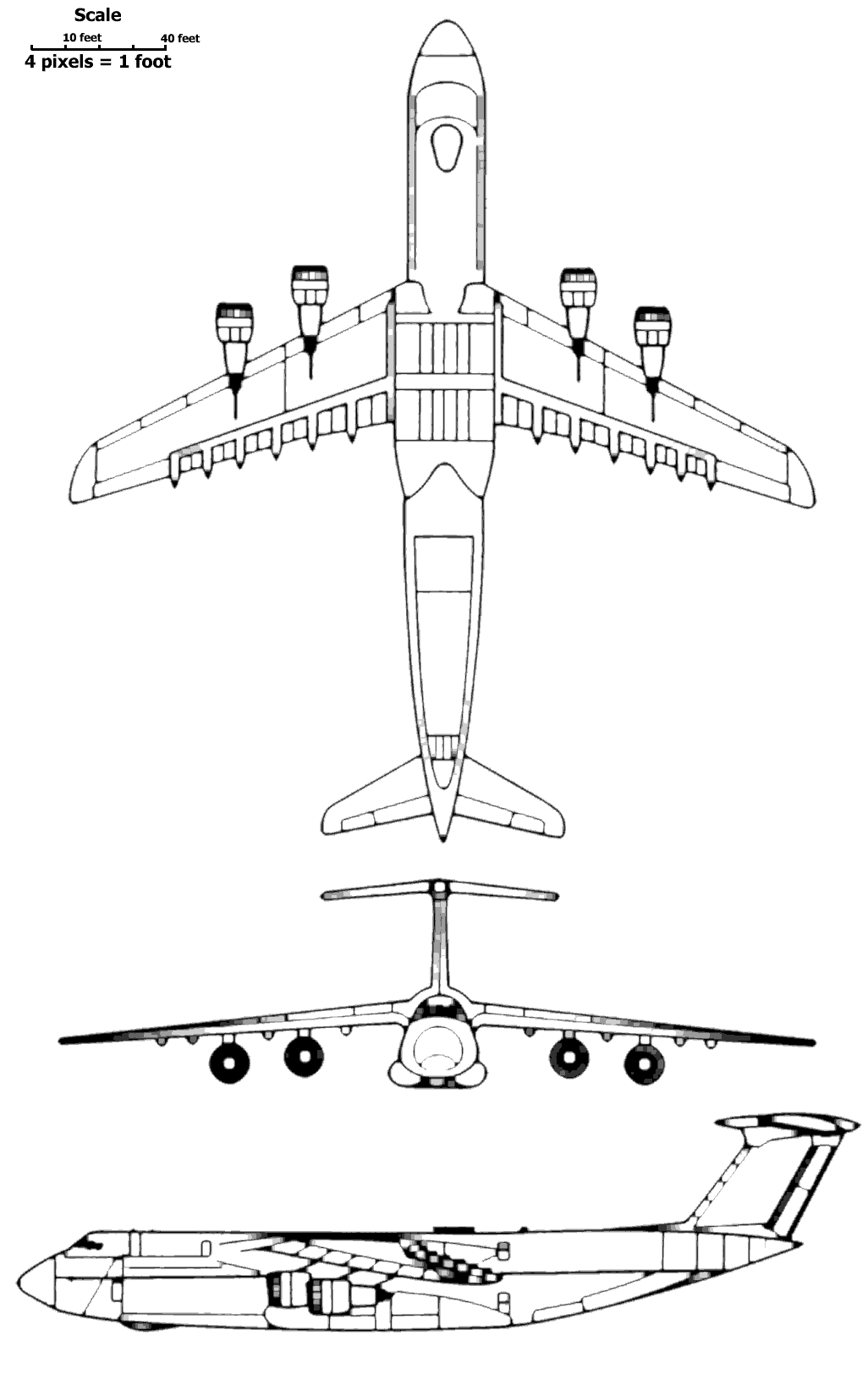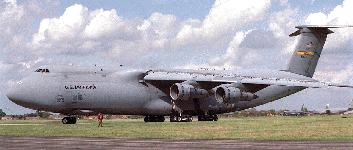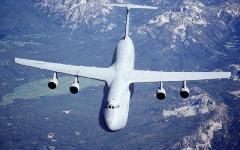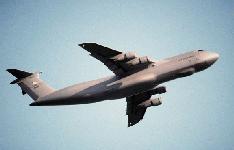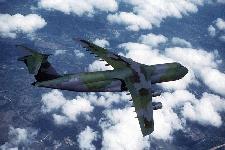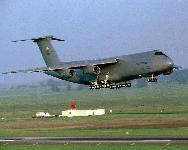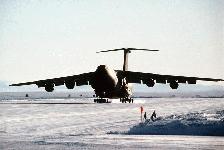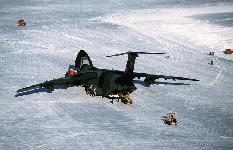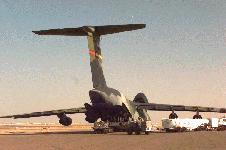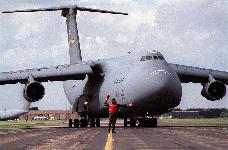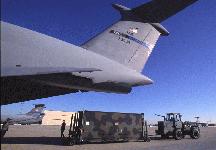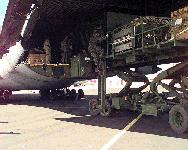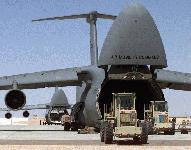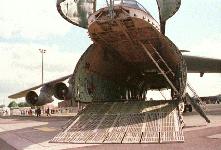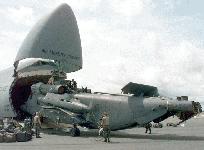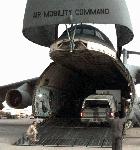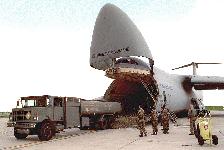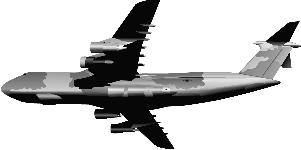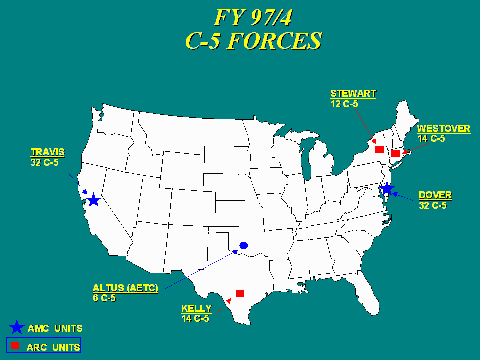



The C-5 Galaxy is a heavy-cargo transport designed to provide strategic airlift for deployment and supply of combat and support forces. The C-5 can carry unusually large and heavy cargo for intercontinental ranges at jet speeds. The plane can take off and land in relatively short distances and taxi on substandard surfaces during emergency operations. The C-5 and the smaller C-141B Starlifter are strategic airlift partners. Together they carry fully equipped, combat-ready troops to any area in the world on short notice and provide full field support necessary to maintain a fighting force.
Using the front and rear cargo openings, the Galaxy can be loaded and off-loaded at the same time. Both nose and rear doors open the full width and height of the cargo compartment, allowing drive-through loading and unloading of wheeled and tracked vehicles, and faster, easier loading of bulky equipment. A "kneeling" landing gear system lowers the aircraft's cargo floor to truck-bed height. The entire cargo floor has a roller system for rapid handling of palletized equipment. Thirty-six fully loaded pallets can be loaded aboard in about 90 minutes.
The Galaxy's weight is distributed on its high flotation landing gear, which has 28 wheels. The landing gear system can raise each set of wheels individually for simplified tire changes or brake maintenance.
An automatic trouble-shooting system constantly monitors more than 800 test points in the various subsystems of the C-5. The Malfunction Detection Analysis and Recording System uses a digital computer to identify malfunctions in replaceable units. Failure and trend information is recorded on magnetic tape for analysis.
Four turbofan engines mounted on pylons under the wings power the C-5. Each engine pod is nearly 27 feet (8.2 meters) long, weighs 7,900 pounds (3,555 kilograms) and has an air intake diameter of more than 8 1/2 feet (2.6 meters). The Galaxy has 12 integral wing tanks with a capacity of 51,150 gallons (194,370 liters) of fuel - enough to fill 6 1/2 regular-size railroad tank cars. The fuel weighs 322,500 pounds (145,125 kilograms) and permits the C-5, carrying a 204,904-pound (92,207-kilogram) payload, to fly 2,150 nautical miles (3,440 kilometers), off-load, and fly another 500 miles (800 kilometers) without aerial refueling.
Features unique to the C-5 include the forward cargo door (visor) and ramp and the aft cargo door system and ramp. These features allow drive-on/drive-off loading and unloading as well as loading and unloading from either end of the cargo compartment. The C-5�s kneeling capability also facilitates and expedites these operations by lowering the cargo com-partment floor by about 10 feet to 3 feet off the ground. This position lowers cargo ramps for truck bed and ground loading and reduces ramp angles for loading and unloading vehicles. The C-5�s floor does not have treadways. The �floor-bearing pressure� is the same over the entire floor. The C-5A/B can carry up to thirty-six 463L pallets. The troop compartment is located in the aircraft�s upper deck. It is self-contained with a galley, two lavatories, and 73 available passenger seats (CB at FS 1675). Another 267 airline seats may be installed on the cargo compartment floor (maximum combined total of 329 troops including air crew over water).
Except for emergencies or unusual circumstances, the C-5 does not carry troops in the lower-deck cargo compartment; but 73 seats are available in the rear compartment of the upper deck for personnel and operators of equipment being airlifted. The C-5 has carried special loads, such as large missiles, that would require extra time, manpower and dollars to transport via ship, rail or flatbed truck.
The forward upper deck accommodates a crew of six, a relief crew of seven, and eight mail or message couriers. The flight deck has work stations for the pilot, co-pilot, two flight engineers and two loadmasters. The upper deck's forward and rear compartments have galleys for food preparation, as well as lavatories.
The Galaxy has sophisticated communications equipment and a triple inertial navigation system, making it nearly self-sufficient. It can operate without using ground-based navigational aids.
The electrical system has four engine-driven generators, each powerful enough to supply the aircraft sufficient electricity. Each of the two main landing gear pods carries an auxiliary power unit to supply electric and pneumatic power for engine starts and ground air conditioning, heating, cooling and ventilation. Air turbine motors in the landing gear pods also can power the hydraulic systems and the main landing gear kneeling motors.
The Galaxy is one of the world's largest aircraft. It is almost as long as a football field and as high as a six-story building and has a cargo compartment about the size of an eight-lane bowling alley. The C-5 is the only aircraft that can transport all of the Army's combat equipment, including the 74-ton (66,600-kilogram) mobile scissors bridge, tanks and helicopters.
The first C-5A was delivered to the Transitional Training Unit at Altus Air Force Base, Okla., in December 1969. The first operational C-5s were delivered to the 437th Military Airlift Wing, Charleston Air Force Base, S.C., in June 1970. In December 1984, the 433rd Tactical Airlift Wing (now the 433rd Military Airlift Wing) at Kelly Air Force Base, Texas, became the first Air Force Reserve wing equipped with C-5 Galaxies.
The first C-5B incorporating significant improvements such as strengthened wings and updated avionics was delivered to Altus Air Force Base in January 1986. C-5 production concluded with delivery of the last "B" model aircraft in April 1989.
The C-5, with its massive payload capability, has opened unprecedented dimensions of strategic airlift in support of national defense. For 20 years it has been involved in many historic airlift missions, and is invaluable to the Air Force mission and humanitarian efforts. For example, in December 1988, four C-5s participated in the delivery of more than 885,000 pounds (398,250 kilograms) of earthquake relief supplies to the then-Soviet Republic of Armenia. The C-5 also assisted with an Alaskan oil spill cleanup in March 1989, transporting nearly 2 million pounds (900,000 kilograms) of equipment to Elmendorf Air Force Base, Alaska.
The most dramatic display of the Galaxy's capability and value was during operations Desert Shield and Desert Storm. The C-5, along with other Air Force transport aircraft, airlifted almost a half-million passengers and more than 577,000 tons (519,300 metric tons) of cargo. This included 15 air-transportable hospitals and the more than 5,000 medical personnel to run them, and more than 211 tons (189.9 metric tons) of mail to and from the men and women in the Middle East - each day.
The C-5 fleet is currently undergoing an Avionics Modernization Program (AMP) to enhance the safety of the aircraft. The program consists of the installation the Traffic Alert and Collision Avoidance System (TCAS), the Terrain Warning and Avoidance System (TWAS, and modern communications, navigation, and surveillance systems. The program redesigns the avionics to replace unreliable components. The program was restructured in FY 2002 due to delays in the avionics redesign. The program should complete installation in FY 2007.
On 04 August 2000 the CF6-80C2L1F turbofan engine was selected by Lockheed Martin Corporation to power the C-5 Galaxy transport aircraft Reliability Enhancement and Re-engining Program (RERP). This engine is a model from the highly successful CF6-80C2 engine family. The C-5 re-engining program is part of a multi-phase effort by the U.S. Air Force (USAF) to modernize its fleet of 126 C-5 aircraft to achieve increased mission effectiveness and readiness.
The AF took delivery of the first C-5A in 1969. The force was then retrofitted with a new wing in the mid 1980s. With a projected structural service life of over 50,000 hours, the C-5 could last structurally well into the next century, depending on the model and other factors. However, system obsolescence, reliability and maintainability, operating cost, impacts of corrosion, and required repairs all factor in the service life of an aircraft. Currently, the C-5 has the highest operating cost of any weapon system, and the trend is a rise in tariff rates and reliability and maintainability costs for the C-5. The current maintenance man hour per flying hour illustrates the difficulties in the C-5 force. The A models consumed 46.0 maintenance man hours per flying hour, 16.7 for the B model (CY96 data).With the retirement of the C-141 force, the C-5 will take a larger role in peacetime movement of cargo over the next few years. This means mobility customers will face a more expensive option with the C-5. Depot levels decreased for the second consecutive year in FY96 to 18 percent of our total aircraft. However, this is still above the planned 15.4 percent BAI level. The daily mission capable rate over the past years continues to improve. However, A-model MC rates average about 10.1 percent below the B-model. These problems raise concern for the economic life of the C-5A-model.
Specifications |
|
| Primary Function | strategic airlift. |
| Contractor | Lockheed-Georgia Co. |
| Power Plant | Four General Electric TF39-GE-1C turbofan engines. |
| Thrust | 41,000 pounds (18,450 kilograms), each engine. |
| Length | 247 feet, 10 inches (75.3 meters). |
| Height At Tail | 65 feet, 1 inch (19.8 meters). |
| Maximum Takeoff Weight | 769,000 pounds (346,500 kilograms). |
| Maximum Wartime Takeoff Weight | 840,000 pounds (378,000 kilograms). |
| Takeoff/Landing Distances |
12,200 feet (3,697 meters) takeoff fully loaded; 4,900 feet (1485 meters) land fully loaded. |
| Wingspan | 222 feet, 9 inches (67.9 meters). |
| Stabilizer Span | 68 feet, 9 inches (20.8 meters). |
| Cargo Compartment |
Height 13 feet, 6 inches (4.10 meters) width 19 feet (5.76 meters). |
| Range | 5,940 miles (5,165 nautical miles) empty. |
| Ceiling | 34,000 feet (10,303 meters) with a 605,000-pound (272,250-kilogram) load. |
| Speed | 541 mph (Mach 0.72) |
| Load | 291,000 pounds (130,950 kilograms) maximum wartime payload. |
| Accommodations | Upper deck seats 73 passengers; forward upper deck seats six, a relief crew of seven, and eight mail or message couriers. The flight deck has work stations for the entire crew. The upper deck's forward and rear compartments have galleys for food preparation and lavatories. |
| Sensors | An automatic trouble-shooting system constantly monitors more than 800 test points in the various subsystems of the C-5. The Malfunction Detection Analysis and Recording System uses a digital computer to identify malfunctions in replaceable units. Failure and trend information is recorded on magnetic tape for analysis by maintenance people. |
| Unit Cost | C-5A, $163.4 million; C-5B, $167.7 million |
| Crew | Six (pilot, co-pilot, two flight engineers, two loadmasters) |
| Date Deployed | December 1969 (for training); June 1970 (operational); December 1984 (to Reserve). |
| Inventory | Active-force, 70; ANG, 11; Reserve, 28. |

